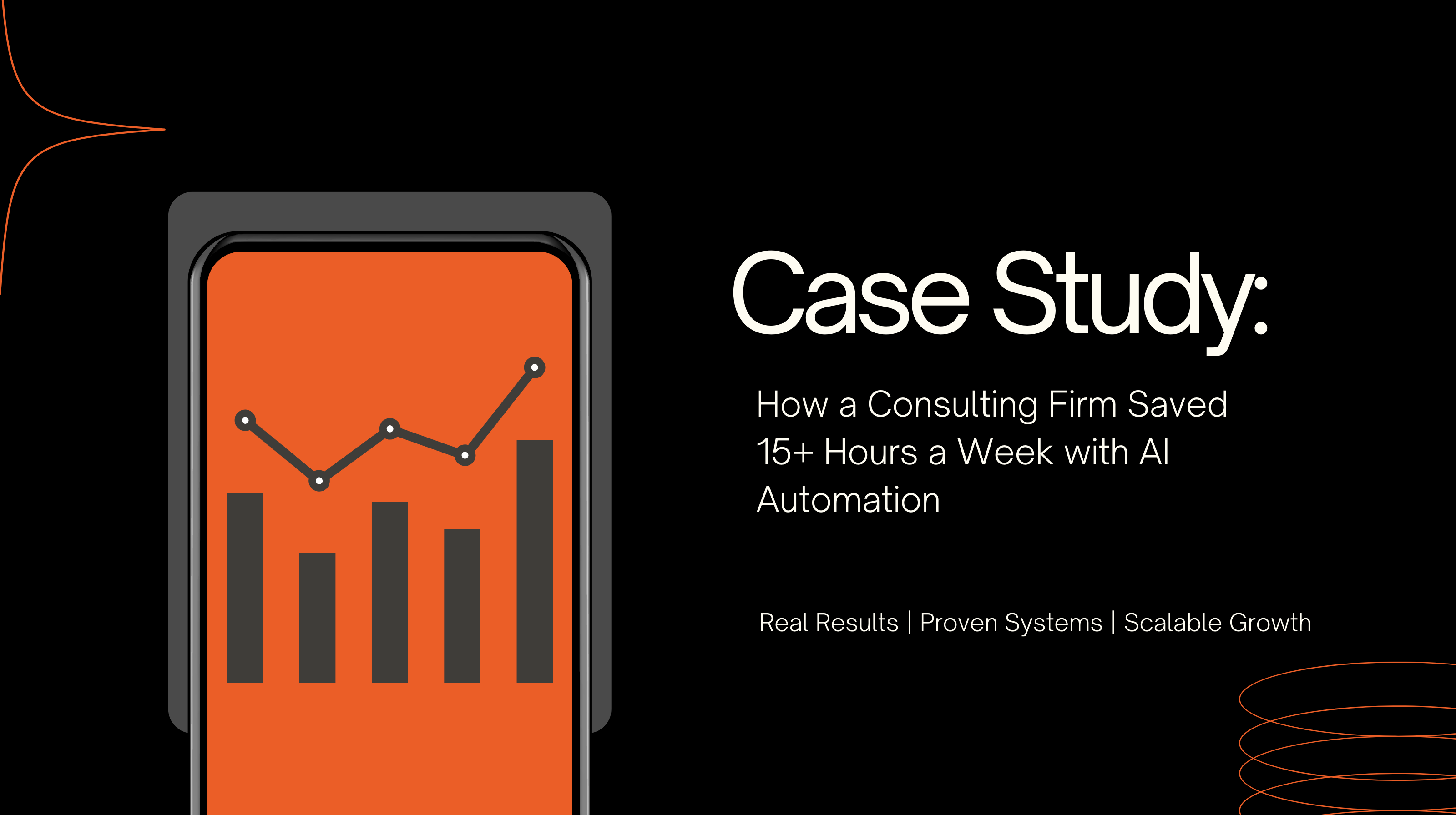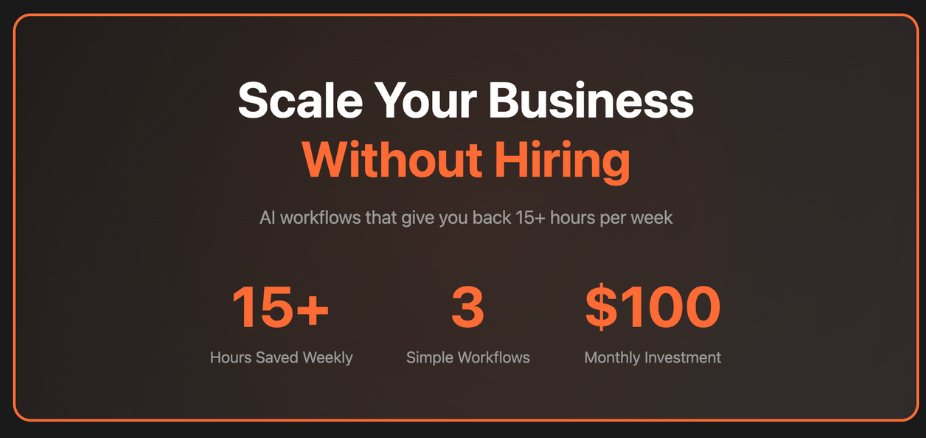Are you an agency leader or founder who feels like your business is succeeding but your team is drowning? Many agencies hit a growth ceiling when success creates more complexity, not more freedom. What got you to your first million in revenue won't get you to five. Instead, it often creates a new set of problems: overworked teams, messy data, and the founder acting as the ultimate bottleneck.
This is the exact challenge we faced with a rapidly growing consulting firm.
They were a powerhouse of talent and expertise, but their success was creating a crisis of time. Their team was losing over 15 hours a week to tedious manual tasks. Their business was growing, but their team's capacity wasn't. They were trapped in the time-for-money exchange.

The Hidden Time Drain: When Success Becomes the Problem
The firm's core issues were a fragmented workflow and a siloed tech stack. Client communications were scattered across email threads and Slack channels, and project status was tracked manually in disconnected spreadsheets. The lack of a single source of truth meant their team was constantly wasting valuable time searching for information and duplicating efforts.
This isn't uncommon. According to a study by IDC, knowledge workers spend about 2.5 hours per day, or roughly 30% of their workday, searching for information. A separate McKinsey report also shows that employees spend 1.8 hours every day—9.3 hours per week, on an average—searching and gathering information. Recent Gartner research found that 47% of digital workers struggle to find information or data needed to effectively perform their jobs.
The financial impact of this inefficiency is staggering. Based on the statistic, a worker spends 2.5 hours per day, looking for information. Assuming now an average yearly salary of 80,000 $, the inability to find and retrieve documents costs an organization, that employs 1000 workers, $ 25 million per year.
They knew they needed to reclaim that time. Their goal was clear: get their team out of the weeds and back to focusing on high-value, strategic work that moves the needle for their clients.

The Devcore Solution: A Systems-First Approach
At Devcore, we don't believe in stacking random AI tools and hoping for a solution. Instead, we design and build systems that create exponential leverage. For this client, that meant a full operational transformation.
We began with a comprehensive data audit to understand exactly where time was being lost. The solution wasn't to buy another piece of software; it was to connect their existing tools and build a unified, automated system tailored to their unique needs.
Here's how we did it:
A Unified Operations Hub: We built a custom Airtable database that served as their single source of truth, consolidating information from their CRM, project management tools, and communication channels.
Intelligent Reporting: We implemented N8n workflows to automatically pull call summaries from Fireflies, updating their Attio CRM and project dashboards with key insights and action items, eliminating manual data entry.
Seamless Communication: We created custom Slack integrations that allowed the team to retrieve real-time project data with a simple slash command, instantly answering client questions without ever leaving Slack.
This system wasn't just a band-aid—it was a new, streamlined operating model that multiplied their team's capacity without adding headcount.

The AI Advantage: Why This Approach Works
The timing couldn't be better for AI-powered business transformation. A recent Gartner report estimates that global AI spending will reach $500 billion by the end of 2024, up 19 percent from 2023. This surge reflects companies realizing that AI has the power to transform work by automating tasks, optimizing operations, and creating better customer experiences.
The adoption rates tell the story: more than 70% (McKinsey survey) of global organizations have already adopted AI for at least one business function, up from previous years. But here's the critical difference—most companies are dabbling with AI tools. Smart organizations are building AI-powered systems.
According to McKinsey's latest research, Gen AI is delivering measurable financial results, with companies noting revenue increases over the course of a year. The key is moving beyond pilot projects to systematic implementation that transforms core business processes.

The Outcome: Scalable Growth & Reclaimed Freedom
The results were transformative. The firm's team instantly reclaimed an average of 15+ hours per week. This translated into a measurable increase in billable hours and a significant reduction in operational overhead.
But the real win was beyond the numbers. The founder and their team were no longer drowning in administrative chaos. They regained the mental space to focus on what matters most: delighting clients, developing new services, and building the business of their dreams. They were now operating with a durable competitive advantage.
The time savings compound across every area of the business:
- Client Communications: Automated status updates and project summaries
- Data Management: Real-time synchronization across all platforms
- Reporting: Instant access to project metrics and team performance
- Decision Making: Data-driven insights available at the click of a button
Why Systems Beat Tools Every Time
This case study is a testament to our philosophy: AI won't replace your team, but your competitors who use AI-powered systems will outmaneuver you. The difference between success and failure isn't which tools you buy—it's how you architect them into a cohesive system that multiplies human capability.
Most agencies make the mistake of adopting AI tools in isolation. They'll implement a chatbot here, an automation there, but never connect them into a unified system. This piecemeal approach creates new silos instead of breaking them down.
By choosing to build a system that works for them, this firm moved from a state of overwhelm to one of unstoppable growth. They transformed from being reactive to proactive, from drowning in data to surfing on insights.
The Competitive Reality Check
Here's the uncomfortable truth: while you're debating whether to implement AI, your competitors are already building systems that will make them faster, smarter, and more profitable than you. The question isn't whether AI will transform professional services—it's whether you'll be leading that transformation or scrambling to catch up.
The firms that thrive in the next decade will be the ones that recognize AI isn't about replacing humans—it's about amplifying human intelligence and creativity. It's about getting your team out of the administrative weeds so they can focus on the strategic, creative work that drives real value.

Ready to Build an Unstoppable System?
Your time is your most valuable asset. Stop trading it for money and start building a business that serves you.
The consulting firm in this case study didn't just save 15 hours a week—they gained the freedom to think bigger, serve clients better, and scale without burning out their team. They moved from being trapped in their business to being liberated by it.
If you're ready to transform your agency from a time-for-money exchange into a scalable, systems-driven powerhouse, we can help. Get your own custom roadmap and see how much time and money you can save with a scalable AI system.
Book a free discovery call with a Devcore strategist today.
Sources:
- IDC Knowledge Worker Study via Copernic
- Gartner Digital Workers Survey
- McKinsey State of AI 2025
- XeniT Information Search Cost Analysis
- HyperSense AI Growth Statistics



